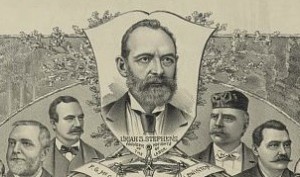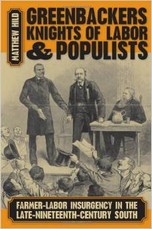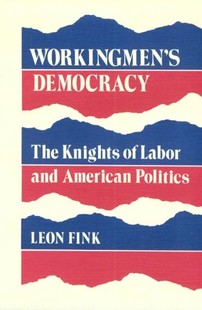Founding of the Knights of Labor, 1869
Introduction
Text-to-speech Audio
Images
Uriah Stephens organized the Knight of Labor in his Philadelphia home with a small group of garment workers in 1869.

Greenbackers, Knights of Labor, and Populists: Farmer-Labor Insurgency in the Late-Nineteenth-Century South-Click on the link below for more information about this book

Workingmen's Democracy: The Knights of Labor and American Politics-Click on the link below for more information about this book

Backstory and Context
Text-to-speech Audio
A brief history of the Knights and their significance in the 19th century labor movement from A History of the United States by David Trowbridge.
"The Knights believed in a radical reordering of the economic system with factories being collectively owned and controlled by the workers. In some ways, this vision was similar to the ideas of those who had advocated collective land redistribution to former slaves following the Civil War. However, like radical ideas about land, the Knights won few converts to their philosophy of collective ownership of factories, although their membership increased in the years that followed.
The Knights attracted a small but devout following in their early years. By 1879, there were 10,000 members when Scranton, Pennsylvania mayor Terrance Powderly was also selected to lead the Knights. Membership grew exponentially to 700,000 members following a successful strike by some members of the Knights in 1886. About ten percent of members were women and African Americans—something that made the Knights very unique at this time but also aroused opposition among other labor movements. Ironically, the philosophy of the Knights of Labor was not one based on winning tactical goals such as raises, but rather on mobilizing politically in hopes of winning support for their more radical goals of eliminating child labor, minimum wages and maximum hours, and eventually collective ownership.
Leaders of various trade unions—the kinds of organizations that represented skilled laborers within a specific craft rather than the general laborers the Knights sought to organize—declared a national work stoppage for May, 1, 1886. May 1 would soon be known as Labor Day and become an international day of worker solidarity. In the meantime, tens of thousands of workers in various leading cities who were affiliated with various trade unions walked off their jobs to demonstrate the power of workers over management. Most returned the next day, but in Chicago, tensions were already high because of a long-standing disagreement and strike at the McCormick Harvester. Although Powderly believed the strike was a mistake, his union had grown far beyond his control, and some laborers affiliated with the Knights participated in this and other strikes throughout the city. McCormick hired strikebreakers, a practice which had led to small-scale violence between union workers and the new employees who were replacing them. On May 3, the two groups clashed and the police opened fire on the crowd, killing four workers.
The following day, thousands of Chicagoans gathered at the city’s Haymarket Square to protest police violence and the intimidation of union workers. An unknown party set off a bomb that injured many in the crowd and killed several policemen. Once again the police fired into the crowd, allegedly in response to armed anarchists who sought to destroy the capitalist system. Eight known anarchists present that day were arrested, and four were executed with little evidence to connect them to the violence. Most newspapers referred to the event as the Haymarket Riot, emphasizing the lawlessness of many in the crowd whose behavior made an otherwise peaceful labor protest turn violent. Others labeled May 4, 1886, as the Haymarket Massacre, emphasizing the deaths of at least a dozen bystanders and police, most of whom were killed by the undisciplined fire of their fellow officers. Because of the radicalism of some leaders present during the Haymarket Affair, radical labor unions such as the Knights of Labor were connected to the violence in the public mind. May 1 would not be celebrated in the United States, as it was in the rest of the world, because government officials viewed labor activism with suspicion. Membership in the Knights and other unions dropped and many Americans began to connect the labor movement to anarchists and communists who advocated any method to destroy the capitalist system."
